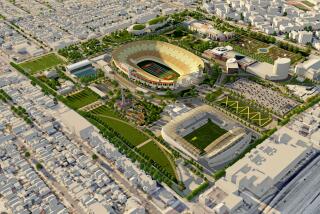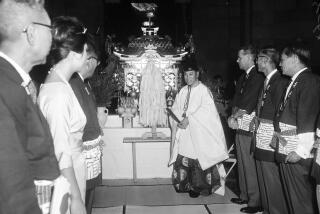Exhibit Depicts How Fair, Balboa Park Altered City
- Share via
SAN DIEGO — About 75 years ago, a stone-faced San Diego businessman convinced the Chamber of Commerce that the city could improve its tepid economy by staging a world fair on an arid piece of chaparral known as Balboa Park.
The plan worked. Not only did the 1915 California-Panama Exposition result in bringing more business and more people to San Diego, it started traditions that became synonymous with the city. The Navy, Spanish-Colonial architecture, the zoo, eucalyptus trees and even San Diego’s pigeon population owe their origins here to the 1915 world fair.
To celebrate the impact the exposition had on the city, the staff of the San Diego Historical Society at the Museum of San Diego History has created “Come to the Fair,” an exhibit featuring photographs, souvenirs, costumes, movies and other artifacts from the exposition.
The exhibit is part of a extravaganza throughout Balboa Park this year in honor of its 75th anniversary. Balboa Park is the second-largest urban park in America, behind only Central Park in New York.
When she began researching “Come to the Fair” about a year ago, society Associate Director Ann Kantor said she wanted to show San Diegans “what a tremendous impact the 1915 expo had on the future of San Diego,” and how it affected the growth of Balboa Park itself.
By spending $2 million to build a “Magic City” on 42 acres above downtown, the city was able to attract hundreds of thousands of visitors, including influential politicians and businessmen who saw San Diego’s natural harbor. Soon after the exposition closed, the Navy claimed San Diego as a base and the city began to grow.
“The only growth issue we had in San Diego at that time is that it wasn’t growing fast enough,” Kantor said. The city fathers “felt they had to promote the city so industry would pick up.”
With the Panama Canal set to open in 1915, San Diego would become the first port north of the canal. G. Aubrey Davidson, the serious-looking businessman and banker, proposed taking advantage of the canal opening to advertise the city’s attractions and finally “put San Diego on the map.”
The exposition may have grown from serious ideals, but the event itself was pure fun. The historical society’s exhibit takes full advantage of the latter, greeting visitors with a large statue of a nude woman that adorned one of the buildings designed and built especially for the expo. Many similar statues can still be seen throughout the park.
The buildings themselves, along El Prado and throughout the park, imitated Spanish Colonial architecture. Kantor said it was the first time any city in Southern California had capitalized on the Spanish and Mexican heritage of the region.
“The city was really changed by this type of architecture,” she said.
Many of the old photographs Kantor had reproduced for the exhibit show how the style spread through the city, including downtown’s magnificent Spanish-style Santa Fe Railroad station, which is still used today.
Horticulturists spent a year landscaping the park for the fair. They brought in hundreds of plants that were not native to San Diego County, including the now familiar eucalyptus tree. Pigeons were also imported, and became one of the most popular attractions at the fair, Kantor said.
A tiny menagerie in the park--including a tiger, lion and bear--formed the nucleus for the San Diego Zoo after the exposition.
Most of the buildings erected for the fair were to have been torn down when it closed, but city voters passed a bond issue to save Balboa Park. One section that didn’t survive, however, was the “Fun Zone,” a midway of fun houses and exhibits including an ostrich farm, a trained-steer show and a Lipton Tea plantation where tea was grown, harvested and served to expo visitors.
Visitors to “Come to the Fair,” can also see two silent movies about the fair, both made on site during its two-year run which began Jan. 1, 1915.
“Come to the Fair,” is open Wednesday through Sunday from 10 a.m. to 4:30 p.m., through May 6. Admission is $2 for adults; children 12 and under, and museum members are admitted free.
More to Read
Sign up for Essential California
The most important California stories and recommendations in your inbox every morning.
You may occasionally receive promotional content from the Los Angeles Times.










